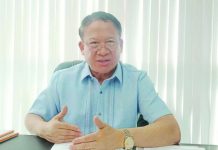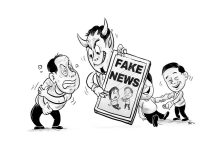
WE START with this bit of foreplay…
Lately, social and mainstream media were in a frenzy over the repartee between a certain Mikaela Suansing, representative of Nueva Ecija’s 1st Congressional District and currently House of Representatives’ chairperson of the Committee on Appropriations, and Navotas City’s Cong. Toby Tiangco during a briefing on the proposed 2026 national budget.
The buzz was on the faux pas committed by Suansing when she, visibly shaken, stumbled under pressure and could not produce a single copy of the signed 2025 Small Committee report re: budget. No archive, no e-copy, nothing.
Suansing was brought down to earth and schooled by Tiangco on House Rules – Sections 2 & 3 of the Declaration of Principles and Policies, Section 39, Rule 9 — reminding colleagues that public office is a public trust, and every committee must issue formal reports. Embedding committee findings into the General Appropriations Bill does not replace this legal obligation. A bill is a law in draft; a report is proof, evidence, accountability. (OPTICS Politics 8/19/2025)
And we segue to the topic at hand – the South China Sea or West Philippine Sea, depending on your biases, common sense, intelligence, or the lack of it. Let me educate you on how this charade started.
In June 2011, Akbayan representative Walden Bello filed a resolution urging the government to look into changing the name of the South China Sea to “Western Philippine Sea”. According to Bello, the term “West Philippine Sea” did not carry any specific spatial demarcation or geographical specificity and was meant to reflect that the South China Sea was not China’s sea.
Bello stressed that the name “South China Sea” carries subliminal connotations of ownership by China, and renaming the area to West Philippine Sea dealt a psychological blow to China. It was meant to signify and reinforce the Philippines’ territorial claims to the Spratly Islands and refute China’s sovereignty claim over the entirety of a “South China Sea”.
For the uninitiated, Akbayan is a social democratic and progressive political party in the Philippines. It was founded in 1998 by progressive and left-leaning political organizations.
Akbayan traces its roots to the Kaakbay ng Sambayanan, an alliance founded in 1992, by various civil society organizations and left-leaning organizations from the country’s social democratic, democratic socialist, and Marxist traditions.
A few decades back, when Joma Sison’s “revolution” was just starting, he was counting on support for his fledgling New People’s Army (NPA) from the Chinese Communist Party as he was a disciple of “Quotations from Chairman Mao” and other books by Mao Zedong.
Unfortunately for Joma, then President Ferdinand E. Marcos Sr. struck an agreement with the leadership of the People’s Republic of China that in turn for the Philippines to recognize the “One China Policy”, they will not support Joma’s revolution and the NPA.
Because of that “betrayal”, there was no love lost between the leftists and the pseudo-communists’ groups in the Philippines and the People’s Republic of China.
Of course, I’m just stating facts here, I leave it to you to make your own conclusions on Le Affair “West Philippine Sea” or “South China Sea” as the case may be.
Moving on, then President Noynoy Aquino issued Administrative Order No. 29 in September 2012 to refer to waters west of the Philippines as “West Philippine Sea” in government maps, other forms of communication and documents.
The West Philippine Sea refers only to the portions of the South China Sea the Philippine claims as part of the country’s exclusive economic zone (EZZ). The Administrative Order also cited Marcos Sr.’s 1978 Presidential Decree No. 1599 establishing the Philippine EEZ and President Gloria Macapagal-Arroyo’s 2009 Republic Act No. 9522 or the Baselines Law which delineated the baselines of the Philippine archipelago.
Sadly, the term “West Philippine Sea” has sometimes been used to refer to the whole of the South China Sea, though this usage has been denounced as incorrect./PN







